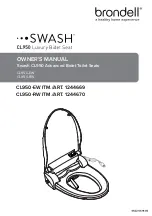
EN-4
EN
4. Before use
Put a layer approximately 5 cm thick (about 20 l) of Biolan Compost
and Toilet Bulking Material, chips or coarse bark on the bottom of
the body to prevent the liquid removal holes from getting clogged.
Fill the evaporating pan with non-fertilised and non-limed peat
(such as e.g. Biolan Peat) or Biolan Compost and Toilet Bulking Ma-
terial, level with the highest notch. The compartment with the lead-
through for the seep liquid hose shall be left empty. Fill up tightly
the space below the body with bulking material up to the lower edge
of the emptying door.
5. Air channel in the toilet tank
Operation of the Biolan Easylett is very effective because of the air
channel (part 4) inside the toilet body. The channel brings the air
required by the compost to the centre of the compost mass – to the
layer where it is most needed. At the same time, the air channel
prevents the compost mass from packing on the bottom and keeps
the mass elevated during emptying. The air channel is visible at the
initial stage, but after that, it is virtually obscured by the mass all
the time.
6. What can be placed in the Easylett
toilet?
The Biolan Easylett is intended for composting toilet waste. Placing
kitchen waste in the Easylett is not recommended. Do not put into
the toilet anything that hampers the composting process or does
not compost, such as:
- debris, sanitary towels
- chemicals (incl. lime)
- detergents, washing water
- ash, cigarette butts, matches
7. Using bulking material
Every time after the toilet is used, apply approximately 0.2-0.5 litres
of Biolan Compost and Toilet Bulking Material over the left mat-
ter. Note that bulking material must also be applied after urinating.
Applying suitable bulking material is essential for proper operation
of the toilet. We recommend using the Biolan Compost and Toilet
Bulking Material as bedding.
8. Year-round use of the Biolan
Easylett
A toilet, installed in a cold space, freezes during winter. Freezing
damages neither the unit nor the compost mass itself and the com-
posting process continues when the temperature rises. A toilet unit
located in a cold space can be used occasionally during winter.
9. To be observed if used in winter
If you plan to use the toilet continuously in winter, install the unit
in a warm space and also make sure that the liquid removal hose,
the seep liquid canister and the evaporating pan do not freeze. If
installing the toilet in a warm space indoors, insulate the ventilation
pipe of the toilet where it runs through cold spaces, for example,
in the intermediate roof space, to prevent condensation of water.
The toilet can be used occasionally in winter (= weekend use) even
if the unit is located in a cold space.
10. Emptying the Biolan Easylett
Remove the ventilation pipe (part 16), leaving from the evaporating
pan cover (part 12), and the evaporating pan cover. Place the emp-
tying trough (part 13) on the edge of the evaporating pan, below the
emptying door (part 5). Open and remove the emptying door. Using
a spade or the emptying aid (part 22), remove some mass from
the emptying door. To enable an efficient uninterrupted compost
-
ing process, we recommend that no more than half of the mass be
discharged from the unit at a time. Do not empty the tank until it
has become full for the first time. There is no need to wash the toilet
tank internally when emptying it.
Toilet waste can be so tough that it does not drop down onto the
bottom of the toilet unit by itself after the emptying. If this is the
case, push the mass down using a sturdy stick or the emptying aid
(part 22). This is easiest to begin from the corners. Be careful not to
break the air channel (part 4) in the centre of the unit.
If the toilet is to be used only in summer, empty it in spring before
using it for the first time. The emptying process is most convenient
and easiest at this stage.
Change peat/bulking material in the evaporating pan in spring be-
fore starting to use the toilet. The mass can be removed by means
of the emptying aid (part 22).
11. Emptying the seep liquid canister
Empty the seep liquid canister as required, however, at least once
a year. You can utilise the seep liquid, that is rich in nutrients, as
a source of nitrogen for compost. This intensifies the activity of the
garden compost in particular, which is poor in nutrients but rich in
carbon. This way, you do not have to dilute the seep liquid.
You can also use seep liquid as fertiliser for ornamental plants in
the yard and garden. A safe dilution ratio is 1:5. Undiluted seep
liquid can also be used, but then you must water the area carefully
after the application to avoid early blight.
Fertilising in the autumn is not recommended so as not to disturb
the preparation of perennial plants for winter. The recommended
storing time for the seep liquid before use as fertiliser is approxi
-
mately one year.
Emptying the Easylett


























